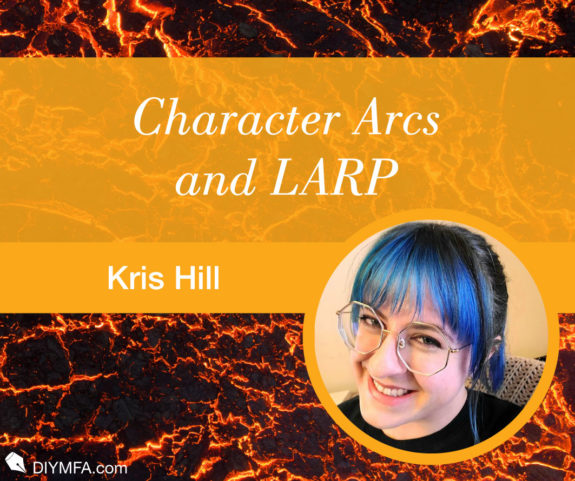Hello word nerds! I want to thank you so much for reading my column this year. I have enjoyed writing for you all and I hope I have inspired some of you to try a game or two. This will be my final column for DIY MFA, thank you for reading, and I’m pulling for all of you to achieve all of your writing goals.
What is LARP?
The collaborative storytelling games I’ve told you about thus far are played around a table with dice and paper. Maps and miniatures may or may not be present, but your friends always are. These types of games are called TTRPGs, or Tabletop games, and they are by far the most common type of collaborative storytelling game because they require fewer players, less time, and much less prep and coordination than the second most common type of collaborative storytelling game.
Live Action Role Playing, or LARP for those that play, is a game where a large group of players meet up for an extended period of time and interact in character for the duration of the game. LARPs often involve costumes, large venues, decoration, and ambiance design. These elements vary wildly depending on the type of game, the setting, and the team running it, but they exist to help players stay in character and occupy the world of the game with a greater degree of immersion.
What types of LARPs are there?
LARPs vary wildly in terms of plot, settings, rules, and gameplay, but there are some common types of LARP games. LARPs may also be a mix of styles as well. This is not an exclusive list by any means, but I hope it will help to illustrate some of the varieties of games you may find.
1. Historical – These LARPs focus on stories set in a particular era, and often involve courts, crusades, and crafts. There are many different games all over the world that fall into this category, such as Ground Zero – a LARP set in a bomb shelter during the Cuban Missile Crisis. I also believe that a lot of civil war reenactments are historical LARPs, but some re-enactors may disagree.
2. Nordic – These games are rooted in the LARPing traditions of Sweden, Finland, Denmark, and Norway. They tend to be rules-light and focus on interpersonal roleplay. They vary in style and setting, but the thing that connects them is their focus on narrative themes and on staying in character throughout. The Future is Straight is a Nordic LARP that addresses gay conversion therapy in a retro sci-fi setting with a focus on love, survival, individualism, and the desire to conform.
3. Blockbuster – These LARPs are often, but not always, destinations for LARP tourism. They take place at impressive venues and place a lot of emphasis on costumes, surroundings, and big events. They are days-long events where participants submit characters before arriving, and are expected to interact in character the whole time. One of the most successful blockbuster LARPs was Fourtune & Felicity, a Jane Austen inspired LARP that took place in Medevi Brunn, a Swedish spa and resort that resembles a small village.
4. Chamber – These LARPs take place over the course of a few hours and usually place more emphasis on storylines that take place over years. Players meet regularly to play episodes of their chronicle. There are many more Chamber LARPs than other types because they do not focus as heavily on venue or production, so they are much more easily organized. They can be independent games that are coordinated by the LARPers within a city, or part of a shared universe of connected games across a wide area. Canada at Midnight (despite its name) is a shared universe of connected chamber LARPs that take place across Canada and the United States.
5. Military Simulation – Also called MilSim, these LARPs include a combat aspect and war games. The game can go on for days and sometimes goes on 24 hours a day for the duration.
6. Boffer – This is the type of LARP that most people imagine. Like MilSim LARPs, These games include an element of combat and often involve fantasy elements. They usually take place over the course of a weekend and sometimes include camping. They are named for foam weapons used in combat.
How can LARP help your writing?
LARP is helpful when writing character arcs because players are speaking, moving, dressing, and thinking in character. Players are responsible for their character’s stories, and the people that run the game set up an open-world setting that characters can explore however they like. LARP differs from Tabletop gaming because the game focuses on creating relationships with other characters.
While you interact as your character, you gain a deeper understanding of their motivations and how they view the world. You inhabit the mind of the character, so it helps you to develop your character’s unique voice. It’s also an excellent tool for first-person narration because you’ve inhabited your character’s mind. Each LARP will be made up of several different types of scenes, which helps you fully explore and pinpoint your character’s perspective.
It helps with dialogue because you have to speak as your character in the moment, and you gain the invaluable resource of what other player’s characters say in response. It is a great way to test emotionally charged scenes.
Other characters in the game are the most important writing resource because they help you develop how your character acts in their relationships with other people, and because every player has their own goals for their characters. You can almost always find a player that is looking to play any character bond you want to explore, be it a familial relationship, friendship, romance, rivalry, and anything in between. Since players are responsible for their own characters and stories, you’ll also be afforded the opportunity to see how your character reacts to events that may have little or nothing to do with them, which I find to be a difficult area of a character’s persona to develop alone.

Kris Hill is working on several genre fiction novels because she has difficulty sticking to writing one project at a time. In her daily life, she attempts to navigate the corporate world as the Senior Marketing Manager for an editing company. When Kris is not working, she can be found sprawled on a couch reading, or running tabletop adventures for her friends. She lives in Canada’s capital city with her husband, her best friend, and three cats.







